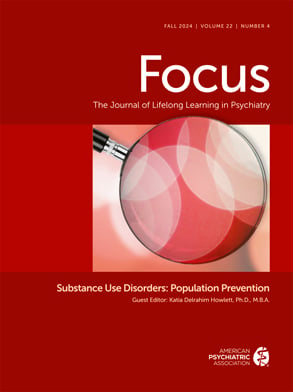Quick Reference for Forensic and Ethical Issues in Psychiatry
| A doctor-patient relationship must be present, creating the following: |
| DUTY of care. |
| DEVIATION from the standard of care must have occurred. |
| DAMAGE to the patient must have occurred. |
| The damage must have occurred DIRECTLY as a result of the deviation from the standard of care. |
| Giving advice to prospective patients, friends, and neighbors |
| Making psychological interpretations during an independent evaluation |
| Writing a prescription or providing sample medications |
| Supervising treatment by a nonmedical therapist |
| Having a lengthy phone conversation with a prospective patient |
| Treating an unseen person by mail |
| Giving a prospective patient an appointment |
| Telling walk-in prospective patients that they will be seen |
| Acting as a substitute therapist |
| Providing treatment during an evaluation |
1. Thoroughly discuss treatment termination with patient. 2. Indicate the following in a letter of termination: b.a. Fact of discussion of termination b.b. Reason for termination b.c. Termination date b.d. Availability for emergencies only until date of termination b.e. Willingness to provide names of other appropriate therapists b.f. Willingness to provide medical records to subsequent therapist b.g. A statement of the need for additional treatment, if appropriate 3. Allow the patient reasonable time to find another therapist (length of time depends on availability of other therapists). 4. Provide the patient’s records to the new therapist upon proper authorization by the patient. 5. If the patient requires further treatment, provide the names of other psychiatrists or refer the patient to a local or state psychiatric society for further assistance. 6. If the need for further treatment is recommended, a statement about the potential consequences of not obtaining further treatment should be provided. 7. Send the termination letter certified or restricted registered mail, return receipt requested. |
| Evidence of child abuse |
| Initiation of involuntary hospitalization |
| “Duty to warn” endangered third parties or law enforcement agencies |
| Commission of a past treasonous act |
| Intention to commit a future crime |
| Human immunodeficiency virus (HIV) infectiona |
a Some states require that the patient’s name be reported.
| Although there exists no consistently accepted set of information to be disclosed for any given medical or psychiatric situation, as a rule of thumb, five areas of information are generally provided: |
|---|
1. Diagnosis: description of the condition or problem 2. Treatment: nature and purpose of proposed treatment 3. Consequences: risks and benefits of the proposed treatment 4. Alternatives: viable alternatives to the proposed treatment, including risks and benefits 5. Prognosis: projected outcome with and without treatment |
| To prevent clear, imminent harm to the patient or others |
| To prevent significant disruption to treatment program or physical surroundings |
| To assist in treatment as part of ongoing behavior therapy |
| To decrease sensory overstimulationa |
| To comply with patient's voluntary reasonable requestb |
a Seclusion only
b First seclusion; then, if necessary, restraints
| For extremely unstable medical and psychiatric conditionsa |
| For patients with delirium or dementia who are unable to tolerate decreased stimulationa |
| For overtly suicidal patientsa |
| For patients with severe drug reactions, those with overdoses, or those requiring close monitoring of drug dosagesa |
| For punishment of the patient or convenience of staff |
a Unless close supervision and direct observation are provided.
| Risk Factor | Facilitating Suicide | Inhibiting |
|---|---|---|
| Anxiety | M | |
| Loss of pleasure and interest in child | H | |
| Depressive turmoil | M | |
| Diminished concentration | L | |
| Therapeutic alliance | H | |
| Family relations | M | |
| Hopelessness | L | |
| Psychiatric diagnosis | M | |
| Prior attempts | O | O |
| Current attempt (lethality) | H | |
| Specific plan | O | O |
| Living situation | H | |
| Employment | L | |
| Availability of gun | M | |
| Suicidal ideation/intent | L (passive) | |
| Family history | H | |
| Impulsivity | M–H | |
| Drug/alcohol | O | |
| Depression/postpartum | M | |
| Religion | L–M | |
| Insomnia | L | |
| Other children | H | |
| Physical condition | M | |
| Cognition/competence | M–H | |
| Marital relationship | M–H |
Overall Risk Rating: moderate–high (at discharge) L = low; M = moderate; H = high; 0 = nonfactor
| The stated desire to hurt or kill another |
| History of violence |
| Alcohol and substance abuse |
| Inability to control anger |
| Impulsivity (e.g., previous violence toward others or self, reckless driving, unrestrained spending, sexual promiscuity) |
| Paranoid ideation, thought insertion or control, fear of harm |
| Command hallucinations |
| Psychosis |
| Personality disorders: antisocial, borderline, and organic personality disorder (explosive type) |
| “Soft” neurological signs |
| Substance abuse |
| Low intelligence |
| Risk Factor | Facilitating Violence | Inhibiting Violence |
|---|---|---|
| Specific person threatened | O (in hospital) | O |
| Past violence | H (stabbed cousin) | |
| Accessible victim | H (mother) | |
| Therapeutic alliance | L–M (with staff) | |
| Psychiatric diagnosis | H | |
| Command hallucinations | O (in hospital) | O |
| Employment | L | |
| Specific plan | O | O |
| Treatment response | H | |
| Medication compliance | H (in hospital) | |
| Structured environment | H | |
| Alcohol dependence | H | |
| Substance abuse | O | O |
| History of impulsivity | H | |
| Guns | L (none at home) | |
| Compliance with aftercare | H | |
| Relationships | M–H (loner) |
Overall Risk Rating: low (at discharge) L = low; M = moderate; H = high; 0 = nonfactor
Information & Authors
Information
Published In
History
Authors
Metrics & Citations
Metrics
Citations
Export Citations
If you have the appropriate software installed, you can download article citation data to the citation manager of your choice. Simply select your manager software from the list below and click Download.
For more information or tips please see 'Downloading to a citation manager' in the Help menu.
View Options
View options
PDF/EPUB
View PDF/EPUBGet Access
Login options
Already a subscriber? Access your subscription through your login credentials or your institution for full access to this article.
Personal login Institutional Login Open Athens loginNot a subscriber?
PsychiatryOnline subscription options offer access to the DSM-5-TR® library, books, journals, CME, and patient resources. This all-in-one virtual library provides psychiatrists and mental health professionals with key resources for diagnosis, treatment, research, and professional development.
Need more help? PsychiatryOnline Customer Service may be reached by emailing [email protected] or by calling 800-368-5777 (in the U.S.) or 703-907-7322 (outside the U.S.).

